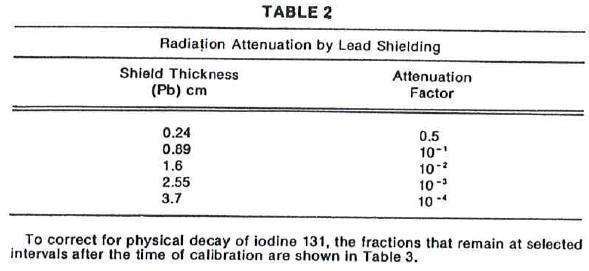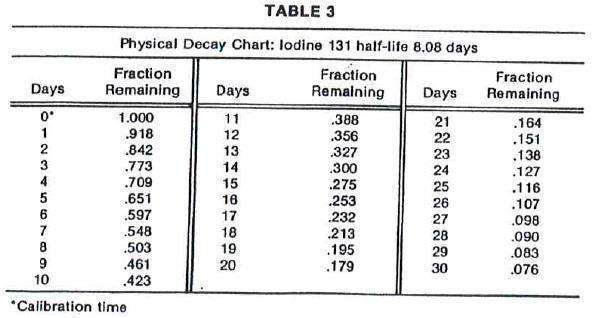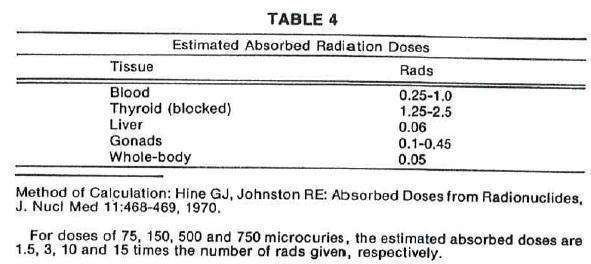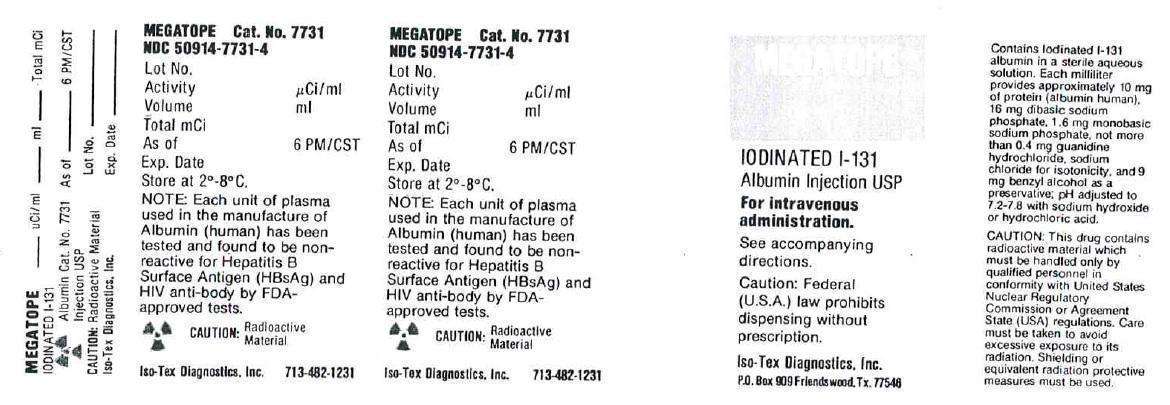Megatope
Megatope
FULL PRESCRIBING INFORMATION: CONTENTS*
FULL PRESCRIBING INFORMATION
CAUTION
Federal (USA) law prohibits dispensing without prescription
MEGATOPE DESCRIPTION
Megatope (Iodinated I 131 Albumin Injection) is a diagonostic radiopharmaceutical
containing iodinated I 131 albumin for intravenous use. Each mL of sterile, nonpyro-
genic, aqueous, colorless to very pale yellow solution provides approximate 10 mg
protein (albumin human), 16 mg dibasic sodium phosphate, 1.6 mg monobasic
sodium phosphate, not more than 0.4 guanidine hydrochloride, sodium chloride
for isotonicity, and 9 mg benzyl alcohol as a preservative. The pH has been adjusted
to 7.2 to 7.8 with sodium hydroxide or hydrochloric acid.
Megatope was prepared from blood that was nonreactive when tested for hepatitis
B surface antigen (HBsAg).
The structure of the complex is unknown.
Iodine 131 decays by beta and gamma emissions with a physical half-life of 8.08 days.1
Photons that are useful for detection and imaging studies are listed in Table 1.

External Radiation
The specific gamma ray constant for iodine 131 is 2.2 R/hour-millicurie at 1 cm. The
first half-value layer is 0.24 cm lead (Pb). A range of values for the relative attenuation
of the radiation emitted by this radionuclide that result from interposition of various
thicknesses of Pb is shown in Table 2. To facilitate control of the radiation exposure
from this radionuclide, the use of a 2.55 cm thickness of Pb will attenuate the radiation
emitted by a factor of about 1,000.


Following intravenous injection, radioiodinated albumin human is uniformly
distributed throughout the intravascular pool within 10 minutes; extravascular
distribution takes place more slowly. Iodinated I 131 albumin can also be detected in
the lymph and in certain body tissues within 10 minutes after injection but maximum
distribution of radioactivity throughout the extravascular space does not occur until
two to four days after administration. The time at which extravascular activity is
maximal has been designated as the "equilibrium time". When this point has been
reached, the radioactivity remaining in the intravascular and extravascular spaces
decreases slowly and exponentially in parallel fashion.
The administered radioactivity is eliminated almost entirely in the urine, only about
2 percent of the total dose ultimately appearing in the feces.
The biologic half-life of Iodinated I 131 albumin is dependent upon a number of
factors, and published studies have varied considerably in their reporting of this
figure. It has ranged, in the literature, from below 10 days to over 20 days. One
important factor affecting the biological half-life is the initial rate of excretion, and this
depends in part on the quality of the Iodinated I 131 albumin. With Megatope, the
biologic half-life in normal individuals has been reported to be approximately 14 days.`
Megatope (Iodinated I 131 Albumin Injection) is indicated for use in determinations of
total blood and plasma volumes, cardiac output, cardiac and pulmonary blood
volumes and circulation times, and in protein turnover studies, heart and great vessel
dilineation, localization of the placenta, and localization of celebral neospasms.
None Known.
A few instances of hyperpyrexia and aseptic (chemical) meningeal irritation have
been reported with the use of iodinated I 131 in cisternography. Iodinated I
131 Albumin injection is not approved for use in cisternography.
General
In the use of any radioactive material, care should be taken to insure minimum
radiation exposure to the patient and occupational workers consistent with proper
patient management.
Radiopharmaceuticals should be used only by physicians who are qualified by
training and experience in the safe use and handling of radionuclides and whose
experience and training have been approved by the appropriate government agency
authorized to license the use of radionuclides.
Carcinogenesis, Mutagenesis,
Impairment of Fertility
No long-term animal studies have been performed to evaluate carcinogenic potential
or whether iodinate I 131 albumin affects fertility in males and females.
Pregnancy Category C
Animal reproduction studies have not been conducted with Iodinated I 131 Albumin
Injection. It is also not known whether this agent can cause fetal harm when adminis-
tered to a pregnant woman or can affect reproduction capacity. Iodinated I 131
Albumin injection should be administered to a pregnant woman only if clearly
needed.
Ideally, examinations using radiopharmaceuticals, especially those elective in
nature, of a woman of childbearing capability should be performed during the first few
(approximately 10) days following the onset of menses.
Nursing Mothers
Since iodine 131 is excreted in human milk during lactation, formula feedings should
be substituted for breast feedings.
Pediatric Use
Safety and effectiveness in children have not been established.
Although the immunological properties of albumin human are believed to be virtually
unaltered by the iodination process, there is a theoretical possibility that allergic
reactions may occur in patients receiving additional doses a number of weeks after an
initial dose.
Megatope (Iodinated I 131 Albumin Injection) is administered intravenously. Parenteral
drug products should be inspected visually for particulate matter and abnormal
coloration prior to administration whenever solution and container permit.
Megatope (Iodinated I 131 Albumin Injection) may be colorless to very pale yellow.
Solutions with excessive colorations should not be used.
When a procedure such as blood volume or a circulation time determination is to
be repeated, the total dosage administered in any one week should not exceed 200
microcuries.
To minimize the uptake of radioactive Iodine by the thyroid, prior administration of
Lugol's Solution (Strong Iodine Solution USP) may be used. Ten drops of Lugol's
Solution three times daily, beginning at least 24 hours before administration of
Megatope and continuing for one or two weeks thereafter, is a suitable dose.
Complete assay data for each vial are provided on the container.
Note: The expiration date given on the container pertains to the biologic properties
of the material and not to the radioactivity level. It is important to make certain that the
radioactivity in the dose at the time of administration is sufficient for the intended use.
The patient dose should be measured by a suitable radioactivity calibration system
immediately prior to administration.
Note: A shielded syringe should be used for withdrawing and injecting the iodinated
I 131 albumin
Total Blood and Plasma Volumes
Dosage may range from 5 to 50 microcuries.
Blood Volume Determination
A. Preparation of Reference Solution
Remove an aliquot of the contents of the vial to be used in the procedure identical in
volume to the dose to be administered to the patient. Prepare a reference solution
using normal saline as a diluent. The recommended dilution is 1:4000 [Dilution Factor
(DF) = 4000]. Determine the radioactivity concentration (net cpm/ml) of the
reference solution. Care must be taken to assure that the reference solution and the
blood samples (Step B3) are assayed using the same geometric configuration.
A. Administration of Dose
1. Inject the dose into a large vein in patient's arm. Measure the residual radioactivity
in the syringe and needle.
2. Destroy the syringe after injecting. Do not attempt to resterilize.CAUTION: The
syringe should be disposed of in accordance with the US Nuclear Regulatory
Commission or Agreement State regulations pertaining to the disposal of
radioactive waste.
3. At 5 and 15 minutes after injecting the dose, withdraw blood samples from the
patient's other arm with a sterile heparinized syringe.
B. Calculation of Blood Volume
1. Take a known aliquot from each blood sample and determine radioconcentration
in net cpm/mL.
2. Plot the 5- and 15-minute sample counts (net cpm/mL) on semilog graph paper
using the average count value of each sample and determine the
radioconcentration at injection time (zero time) by drawing a straight line through
the 15- and 5- minute points to zero time. The x ordinate iof the graph is the sample
withdrawal time and the logarithmic y ordinate is radioconcentration in
net cpm/mL.
3. Calculate the patient's blood volume (in mL) using the following formula:
Net cpm/mL reference solution × DF = blood volume (in mL)
Net cpm/mL patient's blood sample
Sample Blood Volume Calculations
Volume of blood sample aliquot = 1.0 mL
Volume of reference solution aliquot = 1.0 mL
Net counts at zero time = 48,100
Net counts obtained from reference solution aliquot = 52,430
Using the formula above gives 52,430 x 4000 = 4360 mL
48,100
Serial Blood Volume Determinations
Iodinated I 131 Albumin Injection is administered in sufficiently low dosage to permit
repetitions as often as required by clinical circumstances. It must be remembered that
it is always necessary to correct for background radioactivity remaining in the blood
from former determinations. Therefore, for each determination after the first one, a
background blood sample must be taken just before the iodinated I 131 albumin is
injected.
Background Blood Sample:
1. Withdraw background blood sample from large vein in patient's arm with a sterile
heparinized syringe.
2. Leaving needle in patient's vein, detach syringe containing blood sample.
3. Attach syringe containing the dose of Megatope to the indwelling needle and
administer (see instructions under Blood Volume Determination, Administration of
Dose).
4. Determine radioconcentration in net cpm/mL of aliquots taken from background
and postinjection blood samples, and from the reference solution.
The radioconcentration (net cpm/mL) per aliquot of the background blood sample
must be subtracted from the radioconcentration per aliquot of the blood sample
obtained after the injection of Iodinated I 131 albumin. The formula for calculating
each blood volume determination after the first one thus becomes:
Net cpm/mL reference solution × DF = blood
Net cpm/mL Net cpm/mL volume
postinjection minus background
blood sample blood sample (in mL)
Plasma Volume Determination
The procedure is essentially the same as that for blood volume determination, except
that the blood sample drawn from the patient is centrifuged, the red blood cells are
removed, and net cpm/mL of the plasma is determined. The formula for calculation of
plasma volume, therefore is:
Net cpm/mL reference solution × DF = plasma volume
Net cpm/mL patient's plasma sample (in mL)
Cardiac Output
Dosage generally ranges from 3 to 50 microcuries.
Cardiac and Pulmonary Blood Volumes; Circulation Times
Dosages used have generally been 75 to 130 microcuries.
Protein Turnover Studies
Dosages used have ranged from 10 to 150 microcuries. After injection, a period of
seven days should be allowed before determinations are made to permit the
elimination of any degraded protein in the dose.
Heart and Great Vessel Delineation
The suggested dosage is 5 microcuries per kg of body weight, although doses up to
750 microcuries have been used, depending on the instrumentation available and the
scanning technique employed.
Localization of the Placenta
For localization of the placenta in the differential diagnosis of placenta praevia, a 3 to 5
microcurie dose is recommended; this dose has proved adequate for excellent
localization, and the fetal total body radiation is a fraction of that received during x-ray
placentography. While fetal thyroid irradiation is higher with Iodinated I 131 Albumin
Injection than with x-ray placentography, the administration of Lugol's Solution is
reported to eliminate this hazard.
Localization of Celebral Neospasms
The suggested dosage is 5 microcuries per kg of body weight. Although doses as
large as 500 microcuries of Iodinated I 131 Albumin Injection have been used, the
dose should be kept as small as possible. Dosage is administered six hours before the
initial examination, and scans are repeated at periodic intervals.
Radiation Dosimetry
The estimated absorbed radiation doses to an average patient (70 kg) from an
intravenous injection of 50 microcuries of Iodinated I 131 Albumin Injection USP are
shown in Table 4.

Megatope (Iodinated I 131 Albumin Injection USP) is available in multiple dose vials
containing the following amounts of activity on the date of calibration: 500
microcuries and 1.0 millicurie. Complete assay data for each vial are provided on the
container.
The maximum concentration of Iodinated I 131 Albumin Injection does not exceed
one millicurie per milliliter at a time of calibration.
Storage
Store between 2° and 8° C.
This radiopharmaceutical is licensed by the Texas Department of Health, Bureau of Radiation Control for distribution to persons licensed
pursuant to 41.26(b) and Appendix 41-C, Group I and Group II, "Texas Regulations for Control of Radiation," or under equivalent licenses of
the U.S. Nuclear Regulatory Commission, an Agreement State, or a Licensing State.
Iso-Tex Diagnostics, Inc.
P.O. Box 909 . Friendswood, Texas 77546 . USA . (713) 482-1231
Telex (ITT) 499-8324 ITDI UI . FAX: (713) 482-1070

MegatopeIodinated I-131 Albumin INJECTION, SOLUTION
| ||||||||||||||||||||||||||||||||||||||||||||||||||||||||||